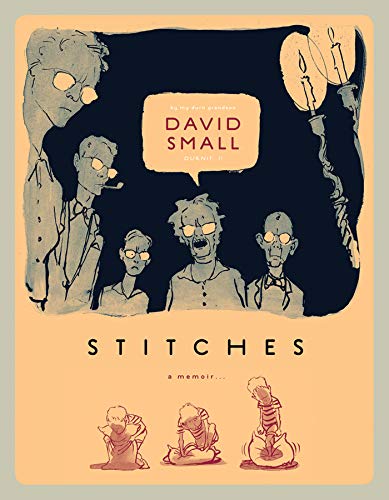Stitches: A Memoir / David Small,
| List Price: | |
Our Price: $37.28 | |
|
For Bulk orders
| |
|
Used Book Price: | |
| Stitches: A Memoir / David Small, | |
| Publisher: W. W. Norton & Company | |
| Availability: | |
| Sales Rank: 141390 | |
|
Amazon Exclusive: David Small on Stitches

Amazon.com: Stitches is a hard story to tell. What inspired you ultimately to write it?
David Small: I needed a direct confrontation with my past. It wasn't easy, but I was ready to do it, so the work--though it was very difficult--felt rewarding, even exhilarating at times.Now that it's become a book it seems so complete, so seamless, and--looking at it now--it seems as if it simply fell out onto the page. In reality it was like herding cats for three solid years, especially after the book was under contract and I was really committed to doing it. But deadlines are great energizers. (So, I should add, are the faith of a great editor, a great agent, and a great wife. I am lucky. I have all three.)
Amazon.com: "Graphic novel" is a form that now encompasses all kinds of storytelling, fictional and factual. As an artist, how would you compare reading pictures vs. words? What might your story lose (or gain) if you told it without pictures?
David Small: I like to say that images get straight inside us, bypassing all the guard towers. You often go to the movies and see people with tears streaming down their cheeks, but you don't see this in libraries, not in my experience at least.
I know now that the graphic form was the only way my memoir could have been told. First of all, drawing is my most fluent means of expression. Secondly, it's a story about being voiceless. It demanded a visual treatment because it involved so much of that guessing game we played in our family, of trying to figure out why someone was mad at us--someone who refused to communicate by any other means than slamming things around. If told in words--even if I could have--the story would have lost that visceral impact.
Amazon.com: Do you read a lot of graphic novels? Are there artists you'd recommend for fans of this genre?
David Small: I've read enough to know that the percentage of really good works in that medium is as small as in any other. For decades I've known and admired the work of Lynd Ward (God's Man, The Silver Pony), a pioneer of the form. Art Spiegelman's Maus and Craig Thompson's Blankets were moving and very pure. Recently I was impressed by Josh Neufeld's A.D.: New Orleans after the Deluge.
A lot of the living artists I admire are European: Blutch, Sylvain Chomet, Winchluss, Frederik Peeters, Nicholas de Cr cy, and Gipi are my favorites.
Amazon.com: We're always curious to know more about what authors like to read. Are there any you'd say who have influenced your own approach to writing?
David Small: I frequently go back to Chekov's stories and to the short works of Henry James and Thomas Mann. John Cheever moves me tremendously.
Since I am a visual artist, the most serious influences came from other artists. I used to get totally infected by contact with any artist whose work I admired. So, for a while, in college, I thought I was, among others, Daumier, Rembrandt, Egon Schiele and Kathe Kollwitz. I would drown myself in their ways of seeing the world, to the point that I sometimes wondered if I would ever have a style of my own.
Amazon.com: One of my favorite scenes in the book begins on p. 62, where you dive into your drawing, Alice in Wonderland-style. It struck me as a cherished fantasy. What scenes might you single out as your favorites?
David Small: I like that one also. I'm glad that you equate it with Alice, because the parallel is certainly there. In fact, though, I intended something truer to my own experience, growing up surrounded by x-rays. At six I knew that x-rays were pictures of the secret places inside us. I imagined myself going down into those shadowy places and finding--what? I don t know. A better world, I suppose. That is what I had in mind but, as I said, I have no problem at all with the Alice reference.
The party scene--where my entire adolescent social life gets summed up in a one-page image also seems to work well. I'm happy with all the dream sequences. The 9-page "rain" sequence, in which the landscape is used as a metaphor for a state of mind, came out as I wanted it.
Amazon.com: The illustrations early in the story on pp 22-23 rendered again, in part, towards the end of the book on pp 290-91 are at once tender and terrifying, and they look remarkably different than most of the other panels that flow between them. Can you talk more about your approach to drawing this scene?
David Small: I tried to draw it the way it felt: that is, being an infant under all that hovering, humming x-ray machinery. If I recall correctly, I put an emphasis on the child's eyes looking around him at the dials, gauges, dangling cords and the blank walls of the machines. Later, the infant's gaze is coupled with the eyes of the young man who revisits the scene in his memory. Then, as the past and present fuse together, comes a shock of revelation. He realizes that what happened to him as an infant has now reached out and shaped--perhaps even ruined--his future. The infant's face and the young man's face converge into one.
Amazon.com: You've illustrated an award-winning roster of children's books. How did writing Stitches impact your style of drawing? Were there elements that took more iterations than others?
David Small: I took the advice of artist Mark Siegel, an old hand at graphic novels who--although his style is entirely different from mine--recommended that I develop a way of drawing that is more like handwriting than regular drawing. "Otherwise," he said, "the whole process will drive you insane." I leapt on this piece of advice because it sounded so right and because it was a direction I'd been moving toward anyway, especially in my sketchbooks. This was a very different effort from my picture book work.
Amazon.com: I'm curious which section of the book you found yourself writing first. Did you find that drawing one part would help you to construct other scenes?
David Small: The scenes in the empty hospital--the elevator ride and so forth--were my strongest childhood memories. Of that whole sequence, the little fetus in the jar stood out most clearly in my mind. I found, as I started drawing, that by some natural-seeming process of visual mnemonics, I could make connections from one thing to another. Then, gradually, whole scenes and episodes would flood back. To put it a simpler way: when I could "see"--that is, draw--the room, and had it all furnished again, the actors (the ghosts) would move in and begin saying their lines. I found all that really quite remarkable.
Amazon.com: Memoirists are often asked questions about memories the tools of their trade, in a way but do you think memories tell the whole story?
David Small: No. They are only your memories. The other people there saw it through their own lens. It s Rashomon. Pure truth doesn t exist. We shouldn't insist on it, and we should always be willing to bend.
Amazon.com: The afterword to Stitches was unexpected, but I found I appreciated the visual reference points for you, and for your mother and father. Why did you feel this was important to include?
David Small: I'm glad you found them helpful. I always do, too, when I'm reading about the lives of others; I go to the photographs, maybe as a way of affirming the descriptive skills of the writer, but also to meet the subjects in a more concrete way. Now you've got me thinking. Maybe I was showing off. It was like saying, "Here! Look! I'm so certain I've done my job well that I'm not afraid to show you these people, whom I've been drawing for 300 pages." Mainly, though, it seemed like the right and fair thing to do.
Amazon.com: Reviews of Stitches seem to swivel on the question of whether the book is redemptive or cathartic. What do you think? Did you write it with any expectation of how you'd feel afterwards?
David Small: Seeing my early life again from the perspective of an adult, I came to know my family members as fellow human beings. I understood their drives. This broke the spell they had over me. It freed me of their influence. I'd had enough, frankly, of living and thinking the way they had taught me to think and behave.
Did I expect that this would happen? No. I had no expectations, only the need to do it.
Now you can buy Books online in USA,UK, India and more than 100 countries.
*Terms and Conditions apply
Disclaimer: All product data on this page belongs to
 .
.No guarantees are made as to accuracy of prices and information.










